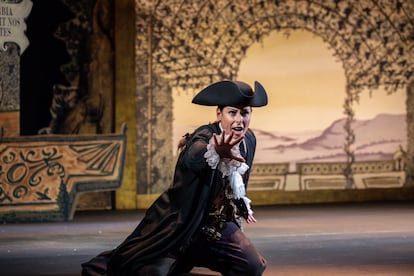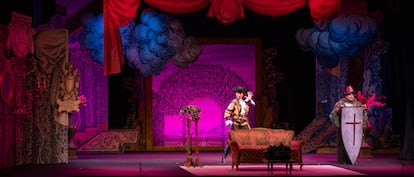On the back of his second trip to Paris, Barbieri understood that the future of Spanish lyric theater did not depend on a national opera in the style of other European countries, but on the reinvention of its own tradition. The premiere in 1855 of The Biscount In the Circus Theater confirmed the insatiable appetite of the public by the minor genres, which flourished in the Madrid billboard with lyrical sainetes, hors d’oeuvres and variety numbers. “It was the time of the so -called theater for hours, with dramaturgies and companies specialized in short, agile and affordable works,” explains Master Miquel Ortega, who runs the recovery of this comic zarzuela in Barbieri on Wednesday. “This light formula frenzy would end up crystallizing, two decades later, in the famous little genre.”
As in Spain in the mid -nineteenth century, in The Biscount Nothing is what it seems. The plot, on a cunning widow who intends to marry her daughter with a nobleman who turns out to be an impostor, finds her equivalent in a score that mimics the conventions of the opera would be to laugh at her through light numbers, Spanish dances and popular melodies. “Barbieri’s orchestration is loaded with irony, because in it we find references to Mozart, Rossini and Offenbach but deflated from any attis of solemnity, with the sole purpose of becoming understood by everyone,” continues Ortega, author of the arrangement for sextet of this transatlantic co -production with the theater of the Zarzuela, the theater of the theater of the zarzuela, Medellín, where he will travel next year. “It is a first quality music that seeks to make laugh.”
With that goal the assembly of Alfonso Romero converts The Biscount In a soap opera to which the characters of another work of Barbieri fall into oblivion, the entremés are hooked Cat per habrea fun tangle loaded with social criticism that saw the light in 1856 at the same circus theater. “To combine both pieces and return them to the present it occurred to me to move the action to the living room of a house in a accommodated neighborhood of Madrid from the seventies,” says the stage director. “There two aristocratic widows chat happily over their love scarves and their addiction to beauty treatments while the television broadcasts a chapter of their favorite soap opera.” The gallant of the screen is none other than the ridiculous suitor of the original libretto of The Biscountwho claims to be a descendant of the Cid himself.
In their efforts to ridicule the frivolous aspirations of these high -society ladies, Barbieri, who became a member of the Royal Spanish Academy, wrote the papers of the Countess and the baroness for male voices of baritone and tenor. “The same happens with The Biscountwhere the protagonist is embodied by a woman, ”says Romero, who wanted pit-stop”, Says) and Tramoya movements inspired by the genuine function of Entremés as a“ appetizer ”between an act and act of a more extensive work.“ The transvestism in Barbieri does not have the political or social reading that could be given today, but responds to a scenic and musical logic that serves only to intensify the satire and mocking tone of these stories ”.

It is not the first time that Romero participates in the Musical Theater Cycle of the Juan March Foundation, where three years ago he presented a very effective reading of The Green Knight of Rajmaninov. “The aesthetics, almost pictorial, of that project can not be far from this new approach in a telenovela key,” says the playwright, who admits “without the slightest blush” Cristal and Topacio. “If you think about it, the soap opera has many points in common with the zarzuela: the brevity, the closeness, the language … and, of course, the prejudices that it awakens in its path,” he reflects. “In addition, television aesthetics has allowed me to build a bridge with the youngest viewers and maintain perfectly greased scenic machinery.”
Throughout four functions, soprano Irene Palazón, the mezzo Blanca Valido, the tenor Juan Antonio Sanabria and the Baritone César San Martín, which will alternate in the seven roles of this double program that can be seen until October 1 at the Madrid headquarters of the Foundation and in streaming Through the Marchvivo channel, Classical Radio and RTVE Play. “The small format forces you to work as a street company in which each singer must also perform as an actor, machinist and comic,” he says valid to the rest of an essay. “There is a Belcanto of Donizetian air in the score, but in the dances it beats a Goyesca elegance that can only be from here.” Beyond the voices and the reduced instrument template, Barbieri’s music always leaves space for laughter. That that the composer himself considered the most serious matter in the world.

